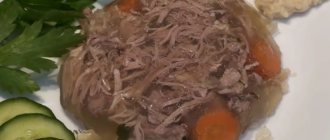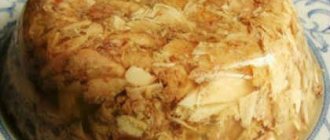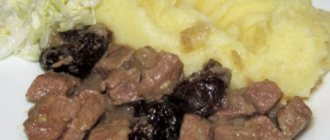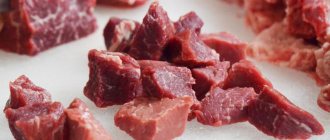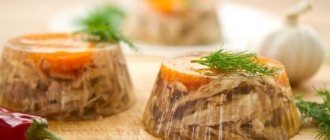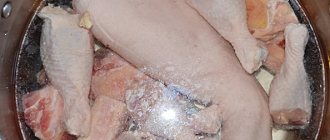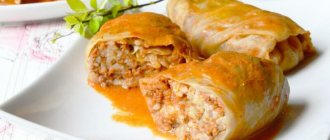We may meet different people on our life's journey. Including those “bruised by glamor.” I once had such a meeting in a catering establishment, where visitors were offered portioned jellied meat that looked and tasted great. But the girl with the duck lips, who happened to be at the same table as me, wrinkled her nose, made by a plastic surgeon, when she looked at this modest portion. “Food of the poor,” she said haughtily. I calmly asked why she made such a fly-by-night conclusion - since I know what good jellied meat is actually made from and how much financial expenditure may be required to prepare it. Unless, of course, you mess around.
It turned out that this was what her Western European “friend” called this wonderful dish in front of her.
Let’s leave it to the conscience of both the “friend” and the girl to make their statements. But then I became furious. Internally. And I decided to find out what this statement was based on, whether it was a German, a Frenchman, or someone else. And I got to the bottom of some interesting facts.
Beef jellied meat
Less informative on the subject, but deeply educational.
It turns out that in Europe it really is the food of the poor. But! Jellied meat, which they prefer to call jelly, is cooked (literally!) from animal horns, hooves and skins. The brew boils and gurgles for many, many hours, up to a day or even more - otherwise how can all this mass be brought into a more or less digestible form? And only then can by-products be added there in the form of kidneys, liver, lungs, so that at least some meaty taste appears in the “dish”.
And then they stopped bothering with this, significantly reducing the cooking time using autoclaves with temperatures up to 140⁰C inside, and using flavoring additives - which generally turned their “jelly” into something of little use.
Jelly
Russian jellied meat is based on joints with cartilage and large pieces of meat on them. Collagen is boiled from the cartilage, from which gelatin can then be isolated, or this collagen will serve as a gelling agent when the bones are boiled for a long time in broth. And for the meat taste, to the amazement of our “Western partners”, in Russia and the post-Soviet space they use (oddly enough) meat. A choice one at that. This is what you will see in the recipes below.
How to cook jellied beef and pork legs correctly and for how many hours?
How long your jellied meat will take to cook depends mainly on the cooking method. In a pressure cooker or multicooker, the process can be reduced to 2-2.5 hours (remember about Western European autoclaves?). In an open pan, where excess steam pressure is not created, the process is extended over a longer time - from 4 to 6 hours.
Bones from pork alone can be cooked for a little more than three hours, then they will separate perfectly from the meat and skin. Joints with veal – more than 4. And “adult” beef will require up to 6 hours of cooking. In this case, it is necessary to take into account that the jellied meat is cooked at the very minimum heat: after bringing to a vigorous boil, it is reduced to a minimum and in this form the light on the gas burner barely smolders in the form of a blue intermittent ring, and on electric stoves the “unit” mode is left when completely closed lid of the pan.
Why is the fire reduced to a minimum? Because when the broth boils strongly, it will become cloudy and unaesthetic. And the taste will suffer. This usually occurs due to the burning of meat and bone parts on the bottom of the dish in contact with the burners in which the jellied meat is cooked.
The total cooking time should also include the time for preparing the first broth, which it is advisable to pour out, since it contains a lot of insoluble protein that is harmful to health. Did you pour water over the meat and bones, put it on the fire, and let it boil? Boil for five to ten minutes and mercilessly pour the resulting mixture into the sink (after opening cold water from the tap, otherwise you will “weld” the plastic “gander” of the siphon on the drain).
After this, after rinsing the meat and bones under cold water to wash off the brown-brown caked-on scale, fill it again with running purified water, add salt and cook, bringing to a strong boil and then sharply reducing the heat to minimum.
Jellied beef and pork feet according to the classic recipe
Pork legs (those with hooves) must be thoroughly cleaned of all possible contaminants before cooking. The vast majority of users of this blog will buy raw materials for jellied meat in specialized stores and on the market, where it is already quite clean, and there will be no need to singe the bristles and then scrape off the soot.
But no one except the cook himself will do it as he needs - so it is better to soak the purchased legs in cold water for at least 6 hours (or better - 12), and then clean out all hard-to-reach places with a knife with a sharp tip.
It’s also a good idea to use a hard propylene, or even metal, sponge.
Ingredients:
- Pork legs – 2 pieces (total weight about a kilogram).
- Beef – 1 kg.
- White onion – 1 onion
- 120 gram carrots – 1 pc.
- Black hot pepper with peas - - 8 peas.
- Carnation - 2 sockets.
- Salt to taste.
- Bay leaf – 1 pc.
- Water – 2 liters.
- Garlic – 3 cloves.
For cooking jellied meat from such a quantity of ingredients, a container of 4-5 liters is suitable.
Preparation:
1. Place washed and cleaned pork legs on the bottom of the pan. Place the beef on top or next to it - you can put it in a whole piece.
2. Put on fire. Bring to a boil, cook for 6-8 minutes without salt and spices.
3. Drain this first broth, cool the meat and legs a little and rinse them under running cold water to remove the gray-brown scum of insoluble protein caked on the surface.
4. Pour water again, bring to a boil, carefully remove the second scum and add salt to the required level, so that the broth is just a little over-salted - some of the salt will be absorbed into the meat, and subsequently into other components, giving the dish a rich taste.
5. Reduce heat to low, add onion and spices to the broth, close everything with a lid.
6. After 4 hours of cooking, add carrots cut into rings, stars, or even whole carrots into the broth.
7. After another half hour, remove from the heat, fish out the meat, place it on a wide dish to cool, and add finely chopped garlic into the still hot broth. While you are cutting up the meat and pork legs, it will give off its flavor to the broth and will not be overcooked.
8. Cut the meat and legs with a knife and fork (or two forks. If you want fattier jellied meat, you can discard the subcutaneous fat from the legs. After separating the meat from the bones, it is sometimes passed through a meat grinder - instead of cutting it into small fragments by hand.
9. Place carrot slices caught from the broth on top of the flattened meat and garnish with sprigs of herbs.
10. Strain the broth from random boiled fragments and bone fragments, fill the molds with the cut meat to the top.
Cool the jellied meat poured into the molds to room temperature and place in the refrigerator to harden. Or immediately take it out onto an unheated balcony or loggia during the cold season.
Homemade jellied beef tail and pork knuckle
Mega-delicious jellied meat made from a budget delicacy - beef tail; to make the dish even more satisfying, you should add just a little pork!
Product list of components:
- pork knuckle – 1 t.;
- bull tail – 1 pc.;
- bay leaf – 2 pcs.;
- salt, ground pepper mixture - to taste.
The cooking process consists of 6 step-by-step steps:
- Both meat products should be soaked for 4-6 hours. Drain the water.
- Be sure to rinse again, washing out the ichor.
- “Place” the meat in a cauldron, add water, its level should be a couple of centimeters higher.
- Simmer over low heat, adding bay leaves.
- Cook for 3.5 hours, remembering to remove the foam “cap”.
- 5-10 minutes before complete readiness, add salt.
- Finely chop the boiled pork and beef, season with pepper, stir, and distribute among the molds.
- Pour in the broth, cool slightly, and refrigerate for at least 5 hours.
The dish is simply delicious, you can safely serve it on a festive table, it will “fly away” instantly! The appetizer turns out transparent and not very greasy.
Cook jellied meat from beef, pork legs and knuckle:
Jellied meat made from pork knuckles, legs and beef turns out to be richer in taste, since the knives will give collagen, the knuckle will give collagen and pork meat, but beef... it's beef.
Pork knuckles have the unpleasant property of “shrinking” in boiling broth, changing shape and pushing other ingredients out of the broth. To prevent this from happening, select a cooking pot with a small amount of free volume, or carefully arrange the components of the future jellied meat so that they have room to move when the shape of the joints changes due to the contraction of the cooked ligaments.
Ingredients:
- Pork legs - 2 pieces.
- Pork knuckle – 1 pc.
- Beef on the marrow – 1 kg (ratio of meat to bone approximately 5 to 1)
- Carrots – 150 g.
- Garlic – 4 cloves.
- Onion – 1 head
- Salt to taste
- Black peppercorns 8-10 peas
- Ground coriander – 1 teaspoon without top.
- Water 4 liters
Preparation:
1. Place the meat and bones compactly in a 5-7-liter saucepan, add water and bring to a boil without salt and spices. The beef can be cut and distributed evenly between the legs and shank.
2. After boiling for 10 minutes, drain the broth, rinse the meat and bones from adhering scale, and cook again, pouring cold water and this time adding salt.
3. After intense boiling, reduce the heat to a minimum so that when the lid is open, the concentration of the broth is barely noticeable (after closing the pan with a lid, it will still increase and will be just what you need).
4. Cook for 5 hours, then add carrots, spices, and halved onions to the broth.
5. After an hour, discard the onion, remove the meat and place it on a wide dish to cool, pour the broth into another pan through a sieve to sift out bone fragments and small boiled fragments. Separate the carrots from the strained carrots and place them separately to further decorate the jellied meat.
6. You can put the broth back on the fire and cook finely chopped garlic in it for 5 minutes.
7. Decorate the meat and pork skins from the shanks with two forks, by hand, or minced through a meat grinder, with boiled carrots and herbs, chopped or twigs, and pour in broth.
8. Cool at room temperature and refrigerate until completely set.
Recipe for delicious jellied pork and beef
Kitchen utensils: a saucepan with a capacity of at least 5 liters, a kitchen scale, a wooden cutting board, a garlic press, a ceramic kitchen knife, a deep large bowl, several small containers with high sides or plastic trays.
Ingredients
| pork shin | 1.3-1.5 kg |
| chicken legs | 2 pcs. |
| beef pulp | 300-400 g |
| Bay leaf | 2 pcs. |
| small onion | 2 pcs. |
| medium sized carrots | 2 pcs. |
| garlic | 1-2 cloves |
| salt | to taste |
| crushed black pepper | to taste |
| parsley and dill | 2 branches each |
Step-by-step preparation
Let's prepare the broth
- Place 1.3-1.5 kg of pork shin, two chicken legs and 300-400 g of beef pulp into a pan.
- Fill the meat with cold water and leave it like this for 2-3 hours.
- After this time, drain the water from the pan and thoroughly rinse the meat.
- Fill the components again with clean cold water and place them on the stove.
- Peel 2 carrots, 2 onions and wash them thoroughly.
- Add 2 bay leaves to the meat, and also lower the whole carrots and onions into the water.
- Bring the liquid to a boil, while constantly removing the resulting foam.
- Cover the pan with a lid, leaving a small hole, then reduce the heat to minimum and cook the meat for 4-5 hours.
- During the cooking process, half of the liquid boils away, so after about two hours of boiling, pour 500 ml of cold water into the pan and continue cooking.
- After the specified time has passed, remove the meat from the broth and add 1-2 cloves of garlic, previously passed through a press.
- Then salt and pepper the liquid according to personal taste preferences.
- Finely chop the parsley and dill in the amount of two sprigs with a knife, and then put them in a pan with broth.
- Mix the resulting mixture thoroughly until the grains of salt are completely dissolved and leave the broth as is, covered with a lid.
Let's prepare the products
- Place the boiled pieces of meat on a cutting board and carefully separate the bones by hand, removing veins, skin and other fatty elements.
- We cut the cleaned meat into small pieces, this way we will avoid small bones getting into the dish.
- Place the chopped meat in a deep bowl, then mix the mixture thoroughly.
- Salt and pepper the meat mixture according to personal taste preferences, then mix again.
- Cut the boiled carrots into thin rings.
Let's prepare jellied meat
- Take a plastic tray and place a few carrot rings on its bottom.
- Spread the desired amount of cold cuts evenly on top of the carrots.
- Pour the prepared ingredients with broth.
- Place the dish in the refrigerator for 8-10 hours.
- After this time, remove the tray from the refrigerator and turn it over onto a serving plate.
Jellied meat recipe video
The video below explains step by step how to properly cook jellied meat from beef and pork at home.
How to cook jellied meat with gelatin from pork legs with beef?
In fact, dishes with gelatin are more common in the aspic department. This is the name of the dishes for which “borrowed” gelatin is used - in cases where little collagen from the legs is boiled due to the small number of these legs.
It has the same right to exist as regular jellied meat (and may even look more beautiful due to the transparency of the jelly part), but the nutritional value of such a dish is significantly lower than that of the traditional one.
To prepare this dish you will need the following ingredients:
- Pork legs – 0.5 kg (one large pork leg
- Pork knuckle – 1 pc.
- Beef pulp – 700 g.
- Onion – 1 head
- Garlic – 3 cloves
- Hot black pepper – 6 peas.
- Carrots – 100 g.
- Olives – 150 gram jar
- Water – to completely cover the meat.
- Edible gelatin 15 g
Preparatory stage:
- Soak the pork leg in water for at least 6 hours, then scrape it off with a knife and steel wool.
- Pour 100 ml of cold water over gelatin to swell.
Preparation:
1. Boil the washed, scraped leg, shank and meat over high heat. After boiling, cook for 10 minutes, drain the water, and wash the meat and legs from scale.
2. Let it cook again: after bringing it to a boil, skim off any remaining scale, add salt, and add the onion to the broth.
3. Cook for three hours, then add spices and carrots to the broth and cook for another hour.
4. 5 minutes before the end of this hour, add finely chopped garlic to the brew. Then remove from the heat, place the meat on a wide dish to cool and cut, and strain the broth through a fine sieve. After the broth has cooled to 55-60 degrees, add the swollen gelatin into it and stir until it is completely dissolved.
Do not add gelatin to the broth if the temperature of the latter is above 60⁰C! Its binding properties drop by 3-4 times if the broth is hotter than 60 degrees, that is, the effect of the addition will be almost zero.
5. Cut the meat and place it in a mold. Top with olives, carrot slices and sprigs of herbs.
6. Fill the molds with meat with broth with gelatin dissolved in it.
7. Cool to room temperature, and then put in a cool place to harden completely.
Recipe for jellied beef and pork legs without gelatin
This jellied meat does not require gelatin: the amount of collagen boiled for 5-6 hours from a beef mole (knee or thigh joint with the remains of meat), as well as from pork legs, will be enough to make it hard and elastic when it hardens.
Ingredients:
- Beef joint weighing 1.5-2 kg – 1 pc.
- Pork legs – 2 pcs.
- Beef pulp – 800 g.
- Carrots – 100 g.
- Parsley root – 200 g.
- Hot black pepper – 10 peas.
- Bay leaf – 1-2 pcs.
- Garlic – 4 cloves.
- Mustard seeds - 1 tsp.
- Water – up to 3 l.
- Onion – 1 head.
- Chicken egg – 1 pc.
In this option, due to the presence of beef moth in the recipe, you need to choose a large container, 8-10 liters, because you are unlikely to have a tool for cutting it at home. And in the markets, the meat cutter has recently become an endangered species.
Place this awkward joint, like a suitcase without a handle, at the very bottom of the pan. And fill the voids around with pork legs and meat. In this version, onions are introduced into the brew at the final stage of cooking, simultaneously with carrots and parsley root. The beginning of cooking is traditional for all jellied meats:
- boiling in the first water for 8-10 minutes,
- drain the broth
- washing barely boiled bones and meat from scale.
- and only then are all the components put into repeated, long-term cooking.
Preparation:
1. Place the beef joint in a saucepan, fill it with water, add salt, bring to a boil, reduce the heat to low and cook this part of the jellied meat separately for the first 2 hours.
2. At the end of the second hour, add pork legs and beef pulp. After boiling, remove the inevitable foam of insoluble protein in such cases and simmer over low heat for another 3 hours.
3. Add peppercorns, bay leaves and, if necessary, other spices of your choice into the broth. This could be cloves, coriander, dry ginger, etc. Cook for another half hour at a low simmer.
4. Remove the meat and bones from the broth for cooling and subsequent cutting; strain the broth through a fine sieve.
5. Add carrots, parsley root in small cubes, coarsely chopped onion and garlic into the strained broth. Cook it all for 25-30 minutes.
6. While the vegetables are cooking, cut the meat by removing the skin from the pork legs from the bones, and pass the removed through a meat grinder.
7. Place the resulting minced meat into molds, garnish with cooked vegetables, a cut-off layer of hard-boiled eggs and herbs. Fill everything with broth.
8. Cool the resulting mixture to room temperature and place it in the refrigerator to completely harden.
Beef jellied meat in a slow cooker - a delicious recipe
You won’t find anything simpler or easier than the presented recipe! The whole family will be delighted!
The product list includes:
- veal leg (upper part) – 1.5 kg;
- water – 2 l;
- gelatin – 15 g;
- salt – 1 tbsp. with a slide;
- onion – 1 head;
- carrots – 1 pc.;
- garlic – 3 cloves;
- fresh parsley – 6 sprigs;
- bay leaf – 2-3 pcs.;
- allspice – 5 pcs.
How to deliciously cook beef jellied meat in a slow cooker, step-by-step recipe:
- Rinse the meat and soak in water for 10 hours. Drain the water, rinse again, remove the film. Cut the meat fibers down to the bone.
- Place beef in a slow cooker and add water. Set the kitchen unit to the “Stew” mode, cooking time – 3 hours.
- When ready, drain 1 tbsp. broth, it will be needed to “dissolve” the gelatin, mix the powder, and leave to “swell.”
- Add salt, add an onion cut into 4 parts, carrots cut with a serrated knife and chopped garlic cloves. Throw in allspice peas and bay leaves.
- Start the “Extinguishing” mode for another 1 hour.
- Catch meat and vegetables, remove bones, cut into cubes (size as desired).
- Place parsley, carrot slices and meat on the bottom of the bowl.
- Strain the broth through a sieve with a layer of gauze. Add broth to it, with soaked gelatin, stir. Pour into containers.
- Cover with lids and leave to harden for 6-8 hours.
Beef jellied meat is considered the lowest in calories, with only 81.1 kcal per 100 g of deliciousness. Indescribable taste sensations!
Tips and tricks for preparing jellied meat
The cooking time for meat and bones in jellied meat may vary depending on what animal the joints come from. Therefore, it may make sense to choose varieties that cook faster. Introduce into the cooking process in stages - so that it does not happen that one type of meat is boiled into rags, and the second still needs to be bitten and torn off from the total mass with your teeth.
In this case, the initial cooking is made equal for all types of meat. But when this primary broth is poured out and the pieces of meat with bones are washed, put the beef ones to boil first. After an hour, introduce pork legs, tails and ears, as well as beef pulp, into the cooking process, and after another hour - the shanks with their large amount of pork meat.
Then you will get uniformly cooked pulp, regardless of the type of meat. Which, in fact, gives that same taste to real jellied meat.
For better control of the cooking process, it is better to use a transparent glass lid on the pan (if such a lid is available). With it, it will be easier to monitor the degree of boiling intensity and react in time to undesirable developments.
Yes, and garlic should be added to the hot broth after you have taken the meat out of the pan for cutting - this way it will retain its aroma and pungency. And don’t crush it with a press - it looks much better when chopped into thin slices.
It is better to over-salt the secondary broth a little - during the cooking process, the salt will be absorbed into the meat and vegetables, the overall salinity will decrease to normal, and the jellied meat will have a rich taste.
If you add salt to each ready-made portion while eating, the taste will not be the same! For everything is good in good time.
Sometimes you can find recommendations between cutting meat and pouring the cut broth into the broth to completely drain the broth - in order to remove from it the layer of fat that inevitably floats on top after cooking. But it is much easier to carefully scrape it off with a spoon from an already frozen treat - this way you will reduce the cooking time by an hour or two. Which is important in the pre-holiday bustle.
And, finally, the main thing: jellied meat without horseradish and mustard is not jellied meat! Well, that's what people say.
Author of the publication
offline 1 month
